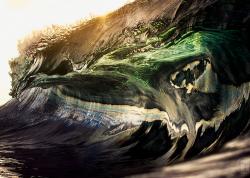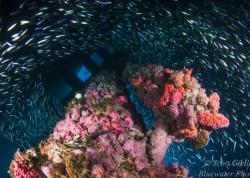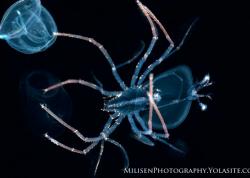How to Shoot Your Way Out of a Slump
I recently checked Raja Ampat off my bucket list. I wanted to see it all - fish schools thick enough to block the sun, coral gardens many acres large, and biodiversity like nowhere else on the plant - and Raja exceeded my every expectation. And yet, after the first few days, I had only a select few photos that I was marginally happy with.
After about a dozen frustrating dives, I had to figure out where I was going wrong and how to fix the problem. The trouble was, in the face of such an incredible amount of life, I was out of my element. I was having troubles picking out a coherent subject in the maelstrom of life. And when I found something, there was often a diver in the background. And then there was the visibility; at 20 meters it was okay, but it wasn’t my Kona gin. Anyone can shoot well on clear days in sunny, familiar waters. Traveling forces you to try your best in the given conditions, because you might not get a do-over. This article is meant to help you re-center your photographic zen when you find yourself out of your comfort zone.
Related: Read our Raja Ampat Scuba Diving Guide.

Isolate a Subject
One of the challenges in shooting a place like Raja Ampat is sorting through the cacophony to find a subject. This was especially challenging at sites like Cape Kri, Melissa’s Garden, and Karaug Bayangan, where the fish form disorganized masses over lush but unbroken coral reefs and bits of carbon element. Just pointing your camera at the cloud of fish isn’t going to capture the beauty. You will still need to work to find an anchor for your photo’s story.
Start simple. Find a large, sessile subject, and just expose it. In Raja, that might mean a wobbegong or a particularly bright coral head. Snap off a few simple portraits. This will give you a few pics to take home, and it will start to pull your headspace out of the gutter. With a few portraits in your back pocket, you can start branching out to get more complicated. Close focus wide-angle shots are made for locations like Raja, but be sure to pick your subject carefully. Not only does the subject have to look compelling, but CFWA relies on a working background, too. I ended up having some luck finding a subject, and then just camping out waiting for the background action to align perfectly.


Managing People
Whenever you are diving with others, they can either be a subject in the photo or a nuisance. When living and diving in isolated, cramped quarters with a small group of others, a small annoyance can snowball into a fight if you aren’t careful. Trouble can be quickly averted when photographers form something of an alliance. On this trip, we all understood that all of our photos would benefit if we could work together. We worked out a few hand signals that politely meant, “hey, you’re in my shot.” If you were in the way, this meant to finish your photo and please move. No offense, no egos, just excuse me for a minute.
A different sort of issue can arise over macro subjects, especially on muck dives, where a diver might want to camp on a rare subject. Again, we all have to work together, so communication is key. I recommend a rotation system for when a line is forming around a particular subject. Agree beforehand that, if someone is waiting, you have x number of shots before you are expected to let the other person have a turn. You can always go back, but it isn’t fair to hog the rarest creature on the reef.

Limited Visibility
This is a tough one, especially for wide-angle photography that relies so heavily on background color. Sure, you can switch to macro and shoot for a black background, but then you will miss the larger opportunities and sweeping reefscapes. For starters, forget about animals that are further away than a few feet. Most of the reef sharks, while cool to watch, will be well outside of this range and not worth considering for good photos. In really turbid water with particles of large atomic size, it helps to stay with action that is as shallow as possible to make use of as much ambient light as you can. Don’t forget to set your strobes wide and angled out. Even so, you can expect to spend some time post-processing backscatter out of most of your images. On the bright side, sunny days in the mid-morning and mid-afternoon produce beautiful God-rays among the speckles in the water. Set your camera for a fast shutter-speed and shoot at 90° to the sun for the most dramatic shots!

Go Back to the Basics
Don’t get so tangled up in missing a few idealized photos that you forget to apply tried and true techniques to the beautiful spot you have found. A solid portfolio from a location should include a healthy mix consisting of the following: split-shots, close focus wide angle, macro, snoot macro, models as the subject, models in the background, snell’s window, marine-life portraits, silhouettes, and black backgrounds. If what you are doing isn’t working, then it is time to switch it up and try a different technique!

Accommodations
I would be remiss if I failed to mention the incredible hospitality and unique accommodations of the SMY Ondina liveaboard. The unique ship was fashioned using hand-tools from the forests of Sulawesi. The plane-marks and cordage stuffed betwixt the floorboards are evidence of the extreme skill required to piece together such a work of floating art. The crew/guides were equally amazing and were quick to drop what they were doing at the slightest hint of a request. I cannot speak highly enough of the experience they provided. To Fede, Hugo, Jobel, and the rest of the crew of the Ondina, cheers!

RECOMMENDED ARTICLES
SUPPORT THE UNDERWATER PHOTOGRAPHY GUIDE:
The Best Service & Prices on u/w Photo Gear
 Visit Bluewater Photo & Video for all your underwater photography and video gear. Click, or call the team at (310) 633-5052 for expert advice!
Visit Bluewater Photo & Video for all your underwater photography and video gear. Click, or call the team at (310) 633-5052 for expert advice!
The Best Pricing, Service & Expert Advice to Book your Dive Trips
 Bluewater Travel is your full-service scuba travel agency. Let our expert advisers plan and book your next dive vacation. Run by divers, for divers.
Bluewater Travel is your full-service scuba travel agency. Let our expert advisers plan and book your next dive vacation. Run by divers, for divers.

































